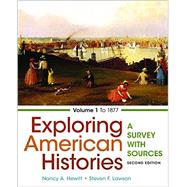Using both written and visual primary sources, Exploring American Histories, Volume 1 illuminates the many histories of this nation while showing you how to think crtically about the sources which lay the groundwork for historical narratives.

Note: Supplemental materials are not guaranteed with Rental or Used book purchases.
Purchase Benefits
What is included with this book?
Using both written and visual primary sources, Exploring American Histories, Volume 1 illuminates the many histories of this nation while showing you how to think crtically about the sources which lay the groundwork for historical narratives.
Steven F. Lawson (Ph.D., Columbia University) is Professor Emeritus of History at Rutgers University. His research interests include U.S. politics since 1945 and the history of the civil rights movement, with a particular focus on black politics and the interplay between civil rights and political culture in the mid-twentieth century. He is the author of many works including Running for Freedom: Civil Rights and Black Politics in America since 1941; Black Ballots: Voting Rights in the South, 1944-1969; and In Pursuit of Power: Southern Blacks and Electoral Politics, 1965-1982.
The New copy of this book will include any supplemental materials advertised. Please check the title of the book to determine if it should include any access cards, study guides, lab manuals, CDs, etc.
The Used, Rental and eBook copies of this book are not guaranteed to include any supplemental materials. Typically, only the book itself is included. This is true even if the title states it includes any access cards, study guides, lab manuals, CDs, etc.